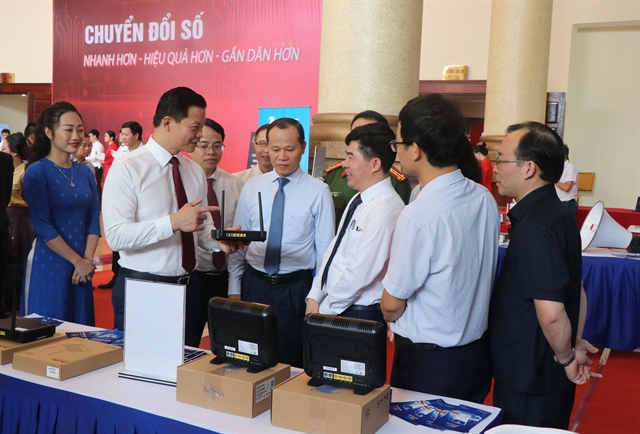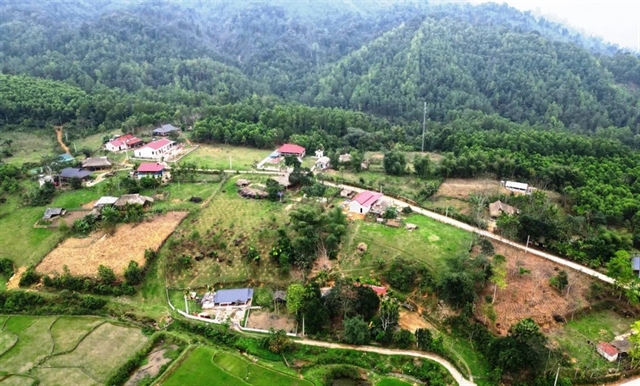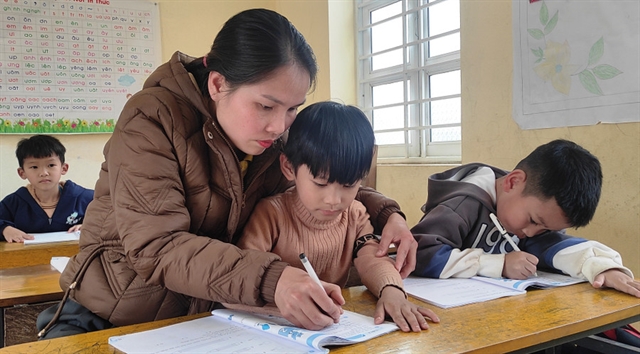 Society
Society

 |
| Húng Village is a home of Thái ethnic group in Thanh Hoá Province. Photo giaoducthoidai.vn |
THANH HÓA – High up on the majestic Bù Rinh mountain range, where the wisps of fog touch the clouds, lies a small village nestled quietly in the chilly mist.
This is Húng Village, in Giao Thiện Commune of Thanh Hóa Province, home to the Thái ethnic group.
Amid the mountain winds and forest mists, the warmth of change is quietly making its way, bringing hope for a brighter tomorrow.
The journey to Húng village is like a trip into a dreamland with an asphalt road weaving through winding slopes, with steep cliffs and dark old forests on both sides.
Phạm Văn Thái, the commune’s Party secretary, said that only a few years ago, this ten kilometre stretch was a nightmare for locals.
“Even the most skilled drivers would take nearly two hours on the bumpy dirt road. During the rainy season, it was as slippery as grease,” Thái told giaoducthoidai.vn.
“Now, motorbikes glide smoothly along the new asphalt road, through a thin veil of white mist, reaching the heart of Húng Village in just 30 minutes,” he said.
Along with road construction, the Government has invested into building schools.
 |
| Campus of Giao Thiện Primary School in Húng Village. Photo giaoducthoidai.vn |
The head of Húng Village, Lê Xuân Hiệp, said: “Back then, the school was makeshift classrooms built with bamboo and thatch. When it rained, water leaked onto the children’s books.
“People were very poor so many children had to drop out because their families could not afford kerosene for lamps,” Hiệp said.
“Now, the newly built school stands firm, powered by the national grid — something the villagers only dared to dream of before 2023,” he said.
Hiệp said: “Government programmes 134, 135 and 30a were like rain during a drought. People received support for crops and livestock, but the steep terrain still makes livelihoods difficult.”
Electricity and road access came late to the village, but their belated arrival has brought miraculous change. Wooden houses now have televisions. Children no longer study under dim oil lamps and literacy is beginning to blossom on the mountainside.
That simple dream is the first fruit of tireless efforts. Húng Village now boasts a 100 per cent attendance rate.
Thái ethnic children here no longer toil endlessly on the fields. Instead, they carry school bags, pencils and hold dreams of escaping poverty through education.
Vi Lê Thảo Liên, a fourth grader, said: “I love going to school! I want to be a teacher one day, so I can teach the younger children in my village.”
 |
| The teacher and her students at Giao Thiện Primary School in Húng Village. Photo giaoducthoidai.vn |
Trịnh Thị Liên, head of Giao Thiện Primary School, said that the spacious school was thanks to both Government support and contributions from villagers.
According to the teacher, Giao Thiện Primary School has one main campus and two satellite campuses of Húng, Khụ and Poọng Villages with 462 students including 232 who are from poor households.
At the Húng campus, there are 37 pupils from grades one to five. Due to the small number of students, the school has combined classes of grades one and two, and three and four.
“This campus has three teachers. One is a local who got married to a villager. The other two commute daily from Giao Thiện Commune now that the roads are accessible,” Liên said.
She said that because Húng is remote, school events often prove challenging for teachers, parents and pupils alike.
“It is nearly ten kilometres of steep, winding roads to the main school. When we need to bring pupils down, the teachers must first persuade parents to drive their children on motorbikes,” Liên said.
“Some students have reached the fifth grade without ever visiting the main school campus,” she said.
A new kindergarten campus in Húng Village has been recently built with funding from a charitable organisation, with three sturdy classrooms with bright red tin roofs.
Trần Thị Huệ, head of the Húng Kindergarten Campus, said five teachers look after the children, who attend full-day sessions.
Each child receives meals costing VNĐ16,000 a day (63 US cents) supported by the 'Highland Meal Project' and the 'Nuôi Em Meal Programme'.
And parents contribute the remainder in cash and rice for daily meals and afternoon snacks.
“One teacher travels nearly 30km from Lang Chánh Town each day, carrying fresh produce to ensure quality and lower costs, as everything here is more expensive,” Huệ said.
The kindergarten now has adequate equipment for teaching and childcare and the teachers even make extra learning materials by hand for playtime.
“The children are very well-behaved and eager to learn. The villagers appreciate us. Despite the remoteness, we are always supported by local leaders, so we encourage one another to keep sowing the seeds of education here,” Huệ said.
Transformation on the mountain
“To date, Húng Village has three children in high school and 19 in secondary, five of whom attend the district’s semi-boarding ethnic minority school,” said Hiệp.
“We already have two nursery teachers from the village. Still, we hope more of our youth become teachers, replacing the women who must come from far away,” he said.
Currently, the two Húng school campuses (nursery and primary) have no male teachers — only female teachers who have settled in the village.
Trương Thị Hân, head of the Húng Primary School Campus, is originally from Cẩm Tâm Commune of Cẩm Thủy District and has worked in Giao Thiện Commune for 25 years.
She now continues her work in Húng Village.
Hân said that thick fog often blankets the village so heavily that visibility drops to just a few metres—posing a danger for teachers commuting to school.
She recalled how, in the past, teachers had to trek on foot as the paths were impassable by motorbike. The school had to rotate teachers annually to share the hardship.
“Conditions are much better now. We have paved roads, electricity, and mobile signal. Every time I come here, seeing the children so respectful and studious makes me truly happy,” said Hân.
Đinh Thị Hương, chairwoman of Giao Thiện Commune's People’s Committee, acknowledged that Húng is the most remote and challenging of the commune’s villages.
However, with government support and preferential policies, the villagers have made strides in economic development and are reaching for a better future.
Despite ongoing hardships, villagers value education deeply. More children are attending preschool at the appropriate age, and Húng has among the highest school enrolment rates in the commune.
Nguyễn Ngọc Sơn, head of Lang Chánh District’s Education and Training Office, said Giao Thiện is one of the poorest communes in the district, and Húng Village’s difficult terrain slows its development.
Yet encouragingly, local families are increasingly prioritising education. VNS